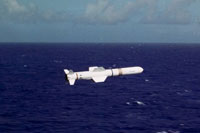The Harpoon
is an all-weather, over-the-horizon, anti-ship missile system,
originally developed by McDonnell Douglas of the United States, with
development and manufacturing now taken over by Boeing Integrated
Defense Systems.
Over 7,000 Harpoon units have been delivered since the weapon's
introduction in 1977. The missile system has also been further
developed into a coastal strike version, the Standoff Land Attack
Missile (SLAM).
The Harpoon uses active radar homing and low-level, sea-skimming
cruise trajectory to improve survivability and effectiveness. The
missile's launch platforms include:
-
Airplanes
(AGM-84, without the booster);
-
Surface
ships (RGM-84, fitted with a solid rocket launch booster that
detaches when expended to allow the missile's integral turbojet to
maintain flight);
-
Submarines (UGM-84, fitted with a solid-rocket launch booster and
encapsulated in a container to enable submerged launch through a
torpedo tube);
-
Coastal
defence batteries.
The chief
competitors of the Harpoon are the French Exocet, the Swedish RBS15,
the Russian SS-N-25 Switchblade and the Chinese Yingji.
|
HARPOON Specifications |
|
Type |
Anti-Ship
Missile |
|
Manufacturer |
Boeing |
|
Weight |
Sea launched 662kg, air
launched 515kg |
|
Warhead |
488lb (221kg), penetration high-explosive
blast |
|
Length |
sea launched 4.5m - air launched 3.8m |
|
Diameter |
0.35m |
|
Wingspan |
0.91m |
|
Performance |
Range >150 miles, speed
855kmh |
|
Propulsion |
Teledyne Turbojet and
solid propellant booster for surface and submarine launch |

